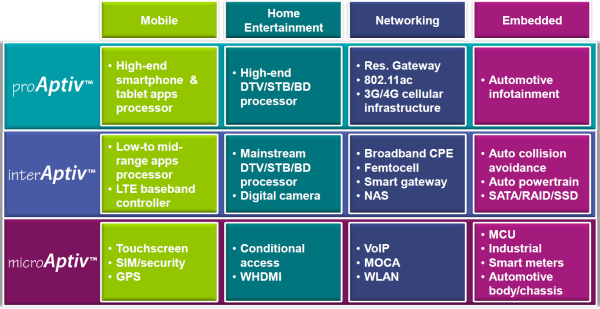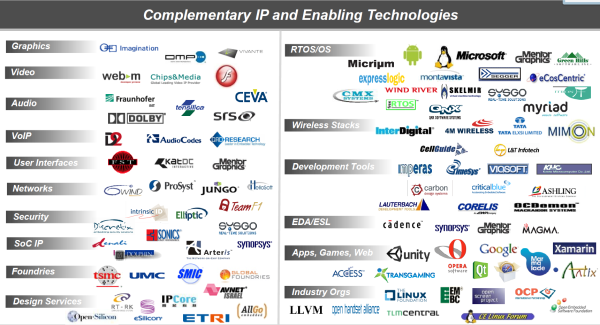MIPS Technologies Updates Processor IP Lineup with Aptiv Series
by Ganesh T S on May 10, 2012 8:55 AM ESTMIPS launched the 1074K CPS in September 2010, and till now, we have seen only one announcement regarding the processor core actually having gone into silicon. Plenty of companies seem to have licensed the IP, but we haven't seen any SoCs announced with the 1074K. eSilicon announced last year that they had taped out the 1074K CPS in Globalfoundries 28nm process, and that they are on the lookout for potential licensees of their hardened IP core. It is clear that at least two years seem to be the bare minimum for volume shipment of announced IP cores. ARM is in the same boat, with the Cortex-A15 being a known entity as far back as February 2011.
Given that the high end proAptiv core delivers performance similar to the Cortex-A15, it appears that MIPS is a little bit late to the game. Being late to the game and not delivering any advantage would have been a disaster. Fortunately, MIPS seems to have been frugal with the area compared to ARM. However, the lack of licensees using the cores in the family to make a push in the high end mobile space is also a detriment. While Qualcomm and Broadcom are MIPS licensees, they are fully committed to ARM as their architecture of choice in the fast-growing mobile space.
Despite the fact that Google is paying attention to MIPS as a platform for Android, it looks likely that the architecture of choice in the mobile / tablet space will become a two way shootout between ARM and x86. That said, the easiest way to lose a fight is to not turn up for it. MIPS must continue to create high performance cores and try to get into mid-range smartphones / tablets for a start. They have a foothold in the low-end space, thanks to Ingenic's tablet platform.
However, the new proAptiv series does have some bright spots for consumers. One can look forward to more powerful home networking equipment and set top boxes. The cores serve to ensure that ARM can't easily encroach upon MIPS's traditional turf. Changing consumer behaviour and the rising popularity of OTT streaming has given ARM a slight opening in the STB / STB replacement space. The new proAptiv cores will definitely be able to help MIPS in this area.
Fortunately, for MIPS, the interAptiv and microAptiv family members seem to hold the upper hand in the battle against ARM's lineup. In the interAptiv series, MIPS has stolen a march over ARM with respect to the multi-threading feature. The integration of a powerful DSP engine in the microAptiv series should open up new markets and strengthen MIPS's position in its current ones.
General production availability of the proAptiv and interAptiv cores is slated to be in the middle of 2012. The microAptiv cores are available for production now. MIPS has also developed strategic relationships with multiple vendors for complementary IP and enabling technologies in order to speed up the SoC development of their licensees.
We look forward to seeing silicon based on the MIPS processor IP cores soon.












40 Comments
View All Comments
sicofante - Thursday, May 10, 2012 - link
What's the meaning of IP here? Thanks.Homeles - Thursday, May 10, 2012 - link
Intellectual Property.http://en.wikipedia.org/wiki/Semiconductor_intelle...
SydneyBlue120d - Thursday, May 10, 2012 - link
Is there something like Mali, PowerVR and so on? And what about Cell modems (LTE and so on)? Thanks.Arnulf - Thursday, May 10, 2012 - link
This is precisely why AMD should be the buyer of MIPS. They can contribute their (ATI's) GPU expertise and AMD's with hybrid processing ... this would be a killer combination.quadrivial - Thursday, May 10, 2012 - link
I agree that AMD and MIPS could be a great combination. I don't know if they could outbid China.The Chinese scientists who started the first (or at least the first to make tech news headlines over here) major Chinese-designed processor had the pick of any architecture they wanted (they weren't paying licensing fees anyway) and they still chose MIPS for the Loongson processors (which are now in devices ranging from small consumer devices to a petaflop supercomputer).
Penti - Thursday, May 10, 2012 - link
AMD/ATi already sold their mobile GPU business to Qualcomm and Broadcom respectably and has none left. They couldn't contribute a great deal here. As they already did to the field. These chips and MIPS Tech itself doesn't compete for the mobile space and any third party building such solutions will use basebands with ARM-cores and normal third party Silicon-IP GPUs. AMD also got rid of their MIPS-based network processors a good while ago. Those building MIPS network processors also do their own architectures (designs) and only license the ISA/Patents. They do things like 16-core 64-bit MIPS processors. Sigma Designs is one company that uses MIPS IP-cores with PowerVR graphics. Some also use Vivante IP/synthesizable GPUs. No different to ARM here except maybe less choice in the market and that it is up to Qualcomm or Broadcom to ship cores with Adreno or Broadcom Videocore/Xilleon. They won't be delivered as IP cores.Also while Broadcom and Qualcomm greatly build on and enhanced their custom design (gpus) from AMD designs that where not exactly Radeon based but other custom designs to develop them into to highly developed and fast gpus, for example nVidia didn't really do that by building "geforce-based" gpus on Tegra where it is greatly under powered and the wrong design for mobiles pretty much. AMD gpus would be disastrous to scale down too. Plus they can sell x86/x64 CPUs / APUs with AMD GPUs for the Android tablet market or Tablet PC market already. They have no reason to go ARM or MIPS (again) just as Intel has no reason to go back to ARM (XScale). They might for servers, but not clients. They can deliver other solutions based on their existing tech there.
Guspaz - Friday, May 11, 2012 - link
MIPS doesn't make the SoC, just the CPU. There's nothing stopping anybody from putting a PowerVR GPU into an SoC with a MIPS CPU.Think about it this way: ARM makes the Cortex A9, but they don't make any chips. nVidia makes the Tegra, TI makes the OMAP, Samsung makes the Exynos, Apple makes the A series, etc. The same thing is true here with MIPS. They just give you a set of blueprints for a CPU and you make it yourself.
sheh - Thursday, May 10, 2012 - link
I had the impression all those routers were running ARM. What's that about no multithreading on ARM? In terms of something like Intel's Hyperthreading?BTW, "upto" -> "up to".
Arnulf - Thursday, May 10, 2012 - link
Most use MIPS chips (something along the lines of an R4000 relative).Jaybus - Thursday, May 10, 2012 - link
Yes, I believe so. ARM has only test-and-set, etc primitive instructions for atomic operations, meaning the OS is essentially performing all aspects of multithreading and context switches are expensive. Unlike x86, it has no hardware allowing for fast context switching.